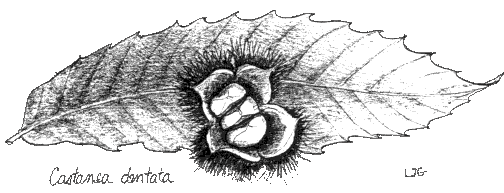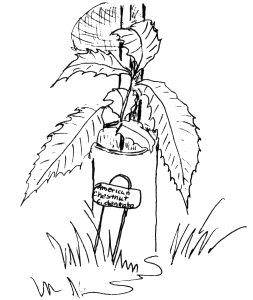American Chestnut Cooperators' Foundation


 Restoration Efforts.....Growing American Chestnuts
Restoration Efforts.....Growing American ChestnutsThis American chestnut seedling, grown from an ACCF seednut, was raised in SC, by Carole Anne O'Neal's Lower Elementary Class at the Charles Towne Montessori School, and transplanted in the Pisgah National Forest, NC, during their spring camping trip. It is protected by a short tree shelter, and staked, with a bag of hair attached to deter deer.
In Virginia, students and teachers from Auburn, Giles, and Narrows High Schools; Macy McClaughery and Narrows Middle Schools; and Narrows Elementary helped in the 2001 harvest at the Martin American Chestnut Planting. Shaun McKim, Virginia Tech Forestry student, helped harvest the seednuts on the Virginia Tech campus. Jenny & Lizzy Cooper, from St. Simon's Island, GA, were excused from school at Frederica Academy, to help in the very early harvest before our group help was scheduled. Since 1997, 4H'ers in 20 Virginia counties have American chestnut growing projects. Several troops of Scouts in West Virginia, Tennessee, Ohio and Pennsylvania also have American chestnut projects. Cub Scout Pack 172, Farragut, Pennsylvania reported 81 American chestnut seedlings growing, with their tallest two-year-old, 5.5 feet; they hold the record. Won't you join in our efforts?
Seeds are shipped (October to March, or until we run out) in damp peat moss, in plastic bags, with pin holes for air exchange, and should be kept in the refrigerator until you are ready to plant them.
ACCF nuts are harvested in a Virginia Tech planting which contains original sources of blight resistance and All-American intercrosses. Blight resistance of the parent trees is inherited by only some of their offspring. When ACCF stock is planted within the area infested by blight, natural selection will reveal the resistant individuals. Trees which have inherited some blight resistance make swollen cankers; those which have not, die within a growing season when sunken cankers girdle the stem. Stump sprouts at the base of the chestnuts killed by blight can be used for grafting stock for scions collected from the chestnuts which develop swollen cankers. To complete the integrated management protocol for American chestnut revival, resistant American chestnuts should be reported to the ACCF.
Direct seeding can produce the best first year growth, by planting seeds at the same time as the squirrels (OCTOBER), so that the tap root begins to grow in late winter, and transplant shock is avoided. Dig a two foot hole; replace half of the fill with compost, well-rotted manure, or leaf mold, mixed with the soil from the hole, fill the hole and mark with a stake near the middle. After the fill has settled, following rain, plant a chestnut on its side under one inch of fill. Install a small (8") tree shelter or gallon milk jug with bottom cut out, over the nut, by driving it into the soil 2 to 3 inches deep, and securing it to the stake. Tops of milk jugs must be cut out to make a large opening after the tree begins to grow in the spring; jugs and tree shelters must be removed in August. This method is suitable for use only in parts of the country where winter brings freezing temperatures, and where raccoons are not known to be a problem. In the presence of varmints, you may still direct-seed, but use a very sturdy stake for the tree shelter and wire its top shut (until May) and install a well-staked weldwire cage with 2" x 4" grid, 4 feet tall and 2.3 feet in diameter, around the nut in its tree shelter.
Start your seed indoors following the Moote Method: make liners by rolling and stapling a large sheet of newspaper to fit inside each 1 to 2 foot tree shelter; fill with a 50/50 mix of sand & peat moss. Place them in plastic buckets in a south-facing window, and plant a nut one inch from the top in each, in February or at least by March. These "pots" permit long root development and a head start on the first season's growth. The buckets make it easy to water and also to move the seedlings, in and out for hardening off and to their transplant site. Newspaper liners degrade in the soil, so seedlings can be transplanted in their pots without disturbing the roots, to minimize transplant shock, although, when you transplant, the newspaper should be pierced at intervals and its top 6 inches should be torn away.
LOCATE SITE: Chestnuts prefer moderately acid, sandy loam soil and sunshine and require a well-drained location. American chestnut plantings have better chances at altitudes below 2,500 feet. For maximum protection from frost, plant on the high ground on sloping land. Avoid known frost pockets, wet spots, and limestone based or heavy clay soil. Chestnuts have both male and female flowers on the same tree but are not self-fertile. At least 2 trees are necessary to make nuts, and they should be no more than 200 feet apart for efficient pollination.
TRANSPLANT: After the last frost date; make holes at least 1 foot wide and 2 feet deep. For good growth, the taproot requires light soil. Usually the taproot is at least as long as the seedling is tall. Avoid disturbing this root by sliding one hand under the newspaper pot for support, as you lift the seedling in its shelter out of the bucket. Hold the shelter upright in the hole so that the taproot will be a few inches off the bottom. Push the soil into the hole, while sliding the shelter upward, and piercing the paper container as you pack fill around it, until the seedling stands on its own. Tear away the top 6 inches of the newspaper pot. Water and push down the soil to prevent formation of air pockets which could kill the tree. Finish filling the hole, tamping and watering as you go, but leave a shallow holding basin for watering. The root collar should be at ground level, the same level at which it was growing in its pot. Install a 5 foot stake beside the seedling and attach the tree shelter to it, pushing down so that the shelter's bottom is an inch into the soil.
Nuts, sprouts & young trees are attractive food for animals and in most areas require PROTECTION. Squirrels, chipmunks, rabbits, voles and mice eat the seeds and young sprouts and gnaw roots and the young stalk. Deer nibble the new growth and rub against the trunks. Deter deer by attaching a mesh bag (in which citrus and onions are marketed) full of human hair (the barber's sweepings) to each tree stake. Hair bags work for one year only. Deer can also be discouraged by moth balls as long as their aroma remains potent. For large plantings, make a double fence line by stringing a single line of 10# test monofilament line (fishing line) about 3.5 feet off the ground. Make a second fence line 10 feet inside the first one. Deer are frightened when they run into the line and it snaps; the second line generally stops them. These fence lines must be walked and repaired on a regular basis, until the deer learn to avoid the area (usually about a month). Mid-western growers say this works better than an electric fence, which deer eventually learn to jump over, because deer can't see the fishline fence. However, if the deer herd in your area is out of control, none of the above measures are likely to work; the only sure-fire protection is staked wire cages 4 ft. in diameter and 4 to 5 ft tall.
Tree shelters offer good first season protection against small animals, weeds, drought, mower and chemical damage. Two foot shelters improve transplant success; taller shelters are not appropriate for chestnut because the large leaves are crowded and cause the stem to grow spindly. Remove shelters in August, at the end of the first growing season. This precaution is advised because in very wet weather the tubes can become incubators for blight, and all young American chestnut seedlings are highly susceptible to blight: they must be at least 5 years old before blight-resistance can be expressed. When ordering tree shelters, request 10% discount for an ACCF project:
|
TREE PRO: 800-875-8071 |
Mulching protects the young plants from extremes of heat, cold, drought, and weed competition. If a deep mulch is used, push it away from the trunk during winter so that rodents will not live there and nibble the tree. Remember that transplants live mostly on water. In dry spells, give each seedling at least one gallon of water per week. Chestnuts do not require a rich soil, but the major nutrients should be balanced. FERTILIZE only in winter or early spring. On poor soil apply compost, well-rotted manure, Miracid, or 10-10-10 in a circle around the the drip line of larger chestnuts or one foot away from new transplants. For plantings on reclaimed mining lands, get a soil test first, then follow guidelines of VA TECH's, Powell River Project.
REPORT to ACCF, P. O. Box 102, Ridgecrest, NC 28770 or by email EACH AUGUST: the number of American chestnuts growing, age and height of the tallest, and any chestnuts that make swollen blight cankers via our Grower Report Form.
If you wish to start more seedlings, request nuts when you report. If not, please consider introducing this tree-growing project to a school teacher and donating your tree shelters for the class project. We would be pleased to supply them with the seed, to involve more of the next generation in American chestnut restoration.
![]()
To learn about other projects for American chestnut cooperators, go to Grafting For Blight Resistance or
Managing
Aging Clearcuts For American Chestnut Revival.
HOME